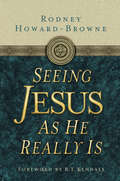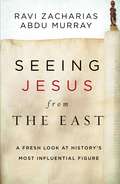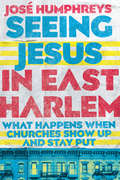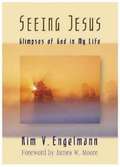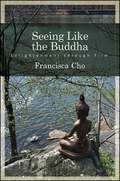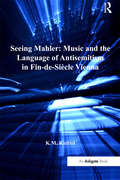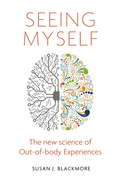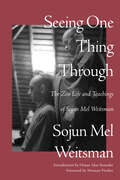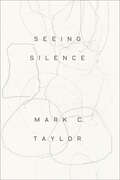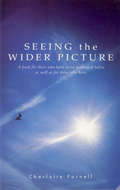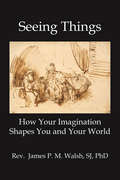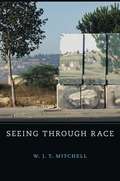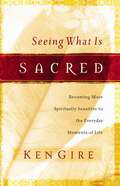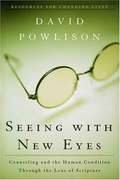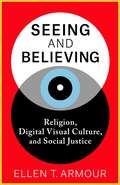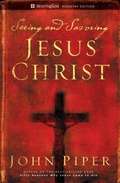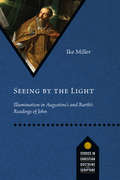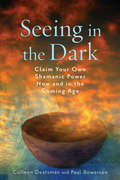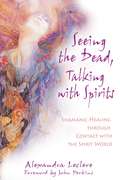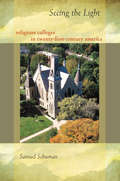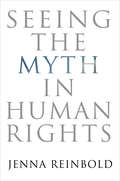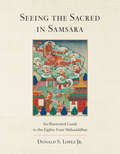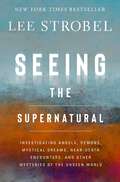- Table View
- List View
Seeing Jesus as He Really Is
by Rodney Howard-BrowneSeeing Jesus as He Really Is takes you on a journey through the Gospels and along the way, you'll see how Jesus really lived, how He radically changed the world, and how Jesus is portrayed through the word of God.Seeing Jesus as He Really Is will help every reader know how to answer the questions that Jesus asked His disciples, "Whom do men say that I am" and "Who do you say that I am?"Chapters include: Jesus and His Methods; The Sweet Presence of Jesus; The Name of Jesus; Called to Do the Works of Jesus; Pressing in to Jesus.
Seeing Jesus from the East: A Fresh Look at History’s Most Influential Figure
by Ravi Zacharias Abdu MurrayEncounter Jesus Like Never Before through Eastern EyesThroughout these pages, Ravi Zacharias and Abdu Murray invite readers to rediscover the cultural insights we often miss when we ignore the Eastern context of the Bible. They offer a refreshing picture of Jesus, one that appeals to Eastern readers and can penetrate the hearts and imaginations of postmodern Westerners.In Seeing Jesus from the East, Ravi Zacharias and Abdu Murray show us why a broader view of Jesus is needed - one that recognizes the uniquely Eastern ways of thinking and communicating found in the pages of the Bible. Zacharias and Murray capture a revitalized gospel message, presenting it through this Eastern lens and revealing its power afresh to Western hearts and minds.Incorporating story, vivid imagery, and the concepts of honor and shame, sacrifice, and rewards, Seeing Jesus from the East calls believers and skeptics, both Eastern and Western, to a fresh encounter with the living and boundless Jesus.
Seeing Jesus in East Harlem: What Happens When Churches Show Up and Stay Put
by José HumphreysWe are all located in different places. And the way we grow as disciples and lead others in spiritual growth depends on our contexts. Pastor José Humphreys recognizes how deeply our faith is tied to our particular stories in our particular places. Grounded in his own deep faith and wisdom, he writes out of his experiences as a Puerto Rican pastor who has planted a multiethnic church in East Harlem. In this book, he offers a framework to help church leaders take discipleship seriously in their places, calling them to show up, stay put, and see what God is doing in their midst. Combining spiritual formation with activism, vivid narrative with exhortation, and realism with hopefulness, Humphreys offers pastors and church planters a thoughtful look at discipleship in a complex world.
Seeing Jesus: Glimpses of God in My Life
by Kim V. EngelmannSeeing Jesus contains a series of short reflections that help the reader see God at work in our daily lives. Though Jesus is an ever-present reality in our lives, we often fail to recognize his presence in the midst of life’s storms and difficulties. Through metaphor and story (both biblical and personal anecdotes), Engelmann reminds us that we are surrounded by, sustained by, and empowered by a God who is intimately present in and through all of life’s experiences. Learning to “see Jesus,” to recognize Jesus’ presence in our lives, is a lifelong process.Contents:Seeing Jesus by Expanding Your ContextSeeing Jesus in Letting Go of What We Cling ToSeeing Jesus in the UnexpectedSeeing Jesus When He Seems Far AwaySeeing Jesus in the StormsSeeing Jesus in the Acorns and Mustard SeedsSeeing Jesus in When You Are Out on a LimbSeeing Jesus In the Master FiddlerSeeing Jesus in Suffering"The miracles of God are all around us but can we see them? People to help, opportunities to serve, and lessons to learn are all around us, but do we see them? The redemptive activities of Jesus Christ are happening all around us, but do we notice? Do we take them in? Can we really see them with our eyes, our minds, our hearts? Dr. Engelmann encourages us to 'open our eyes' and see the presence of Jesus." —from the Foreword by James W. Moore
Seeing Like the Buddha: Enlightenment through Film
by Francisca ChoIn this important new contribution to Buddhist studies and Buddhist film criticism, Francisca Cho argues that films can do more than simply convey information about Buddhism. Films themselves can become a form of Buddhist ritual and contemplative practice that enables the viewer not only to see the Buddha, but to see like the Buddha. Drawing upon her extensive knowledge of both Buddhism and film studies, Cho examines the aesthetic vision of several Asian and Western films that explicitly or implicitly embody Buddhist teachings about karma, emptiness, illusion, and overcoming duality. Her wide-ranging analysis includes Spring, Summer, Fall, Winter … and Spring (South Korea, 2003), Nang Nak (Thailand, 1999), Rashomon (Japan, 1950), Maborosi (Japan, 1995), and the films of American Terrence Malick.
Seeing Mahler: Music and the Language of Antisemitism in Fin-de-Siècle Vienna
by K.M. KnittelNo-one doubts that Gustav Mahler's tenure at the Vienna Court Opera from 1897-1907 was made extremely unpleasant by the antisemitic press. The great biographer, Henry-Louis de La Grange, acknowledges that 'it must be said that antisemitism was a permanent feature of Viennese life'. Unfortunately, the focus on blatant references to Jewishness has obscured the extent to which 'ordinary' attitudes about Jewish difference were prevalent and pervasive, yet subtle and covert. The context has been lost wherein such coded references to Jewishness would have been immediately recognized and understood. By painstakingly reconstructing 'the language of antisemitism', Knittel recreates what Mahler's audiences expected, saw, and heard, given the biases and beliefs of turn-of-the-century Vienna. Using newspaper reviews, cartoons and memoirs, Knittel eschews focusing on hostile discussions and overt attacks in themselves, rather revealing how and to what extent authors call attention to Mahler's Jewishness with more subtle language. She specifically examines the reviews of Mahler's Viennese symphonic premieres for their resonance with that language as codified by Richard Wagner, though not invented by him. An entire chapter is also devoted to the Viennese premieres of Richard Strauss's tone poems, as a proof text against which the reviews of Mahler can also be read and understood. Accepting how deeply embedded this way of thinking was, not just for critics but for the general population, certainly does not imply that one can find antisemitism under every stone. What Knittel suggests, ultimately, is that much of early criticism was unease rather than 'objective' reactions to Mahler's music - a new perspective that allows for a re-evaluation of what makes his music unique, thought-provoking and valuable.
Seeing Myself: What Out-of-body Experiences Tell Us About Life, Death and the Mind
by Susan BlackmoreEssential reading for anyone seeking to understand their own mind and to find a spiritual path that is compatible with scienceAs an impressionable young student, Susan Blackmore had an intense, dramatic and life-changing experience, seeming to leave her body and travel the world. With no rational explanation for her out-of-body experience (OBE) she turned to astral projection and the paranormal, but soon despaired of finding answers. Decades later, a Swiss neurosurgeon accidentally discovered the spot in the brain that can induce OBEs and everything changed; this crucial spot is part of the brain's self-system and when disturbed so is our experience of self. Blackmore leaped back into OBE research and at last began to unravel what had happened to her. Seeing Myself describes her long quest for answers through spirituality, religion, drugs, meditation, philosophy and neuroscience.Anyone can have an OBE, indeed 15 per cent of us have. Even more have experienced sleep paralysis, lucid dreaming and the creepy sense of an invisible presence. At last, with the advent of brain stimulation, fMRI scanning and virtual reality, all these phenomena are beginning to make sense. Long relegated to the very fringes of research, the new science of out-of-body experiences is now contributing to our understanding of consciousness and our very selves.
Seeing Myself: What Out-of-body Experiences Tell Us About Life, Death and the Mind
by Susan BlackmoreEssential reading for anyone seeking to understand their own mind and to find a spiritual path that is compatible with scienceAs an impressionable young student, Susan Blackmore had an intense, dramatic and life-changing experience, seeming to leave her body and travel the world. With no rational explanation for her out-of-body experience (OBE) she turned to astral projection and the paranormal, but soon despaired of finding answers. Decades later, a Swiss neurosurgeon accidentally discovered the spot in the brain that can induce OBEs and everything changed; this crucial spot is part of the brain's self-system and when disturbed so is our experience of self. Blackmore leaped back into OBE research and at last began to unravel what had happened to her. Seeing Myself describes her long quest for answers through spirituality, religion, drugs, meditation, philosophy and neuroscience.Anyone can have an OBE, indeed 15 per cent of us have. Even more have experienced sleep paralysis, lucid dreaming and the creepy sense of an invisible presence. At last, with the advent of brain stimulation, fMRI scanning and virtual reality, all these phenomena are beginning to make sense. Long relegated to the very fringes of research, the new science of out-of-body experiences is now contributing to our understanding of consciousness and our very selves.
Seeing One Thing Through: The Zen Life and Teachings of Sojun Mel Weitsman
by Mel WeitsmanA young painter, coming of age in San Francisco&’s bohemian 1950s, meets his teacher—Shunryu Suzuki, a pivotal figure in Buddhist America—and dedicates his life to continuing Suzuki Roshi&’s teachingsSeeing One Thing Through begins with a series of autobiographical memories and reflections going back to Sojun Mel Weitsman&’s boyhood in Southern California, his coming of age as an artist and a seeker in the vibrant San Francisco of the 1950s, and his encounter with Zen in one remarkable teacher, Shunryu Suzuki Roshi. From that moment, and for nearly sixty years after, Weitsman&’s life took the direct path of Zen—as a student, as a teacher, and as one of the first generations of American Zen masters. The larger portion of the book is a collection of Weitsman&’s edited talks, his articulation of &“ordinary mind,&” and his strong belief that Zen as a way of life is available to all.
Seeing Silence
by Mark C. Taylor“To hear silence is to find stillness in the midst of the restlessness that makes creative life possible and the inescapability of death acceptable.” So writes Mark C. Taylor in his latest book, a philosophy of silence for our nervous, chattering age. How do we find silence—and more importantly, how do we understand it—amid the incessant buzz of the networks that enmesh us? Have we forgotten how to listen to each other, to recognize the virtues of modesty and reticence, and to appreciate the resonance of silence? Are we less prepared than ever for the ultimate silence that awaits us all? Taylor wants us to pause long enough to hear what is not said and to attend to what remains unsayable. In his account, our way to hearing silence is, paradoxically, to see it. He explores the many variations of silence by considering the work of leading modern and postmodern visual artists, including Barnett Newman, Ad Reinhardt, James Turrell, and Anish Kapoor. Developing the insights of philosophers, theologians, writers, and composers, Taylor weaves a rich narrative modeled on the Stations of the Cross. His chapter titles suggest our positions toward silence: Without. Before. From. Beyond. Against. Within. Between. Toward. Around. With. In. Recasting Hegel’s phenomenology of spirit and Kierkegaard’s stages on life’s way, Taylor translates the traditional Via Dolorosa into a Nietzschean Via Jubilosa that affirms light in the midst of darkness. Seeing Silence is a thoughtful meditation that invites readers to linger long enough to see silence, and, in this way, perhaps to hear once again the wordless Word that once was named “God.”
Seeing The Wider Picture
by Charlotte ParnellMeditation is often seen by those who do not practise it as something mysterious, something foreign, even something 'hippy', yet many of us have experienced a meditative state without even realising it.There is an ever-increasing body of opinion, let alone evidence, that meditation is good for you and particularly helps in dealing with stress.This book helps to break down the mystery, by making the practice more accessible, and by giving you a series of simple-to-follow exercises: a step-by-step, how-to guide to meditation. Even experienced meditators should find something to enjoy in the exercises within.This book helps you to start to access a different dimension and a new perspective on what is going on in your life and beyond it. It will start a process in you of looking afresh.It will help you to open your eyes - by closing them - so you can begin to see the Wider Picture.
Seeing Things: How Your Imagination Shapes You and Your World
by Reverend James P.M. WalshThe late Jesuit theologian shares how the imagination “animates our aspirations, our service, and a deeper connection to God and to one another” (John J. DeGioia, President of Georgetown University).“This book is a pedagogical memoir enabling the reader to enter the late Jesuit Professor James Walsh’s Georgetown University classroom in various moments. Rev. Walsh considered imagination central to lived religion in the broadest sense, namely the vision of the prophet, the exegesis of the theologian, the teaching of the professor, the preaching of the pastor, and the experiences of the student, the seeker and the believer. And [Seeing Things] stands as an eloquent and accessible mini-course in the place of imagination in moral theology, as well as the spiritual testament of a caring and loving teacher, healer, and friend.” —David Goldfrank, Professor of History, Georgetown University “This study is a fascinating presentation of how we imagine ourselves and the context of the world around us. Father Walsh’s long-standing commitment to helping his students and colleagues understand both elevates the text to a unique level of contemplation.” —Ronald Jonson, Professor Emeritus of History, Georgetown University
Seeing Through Race
by Mitchell W. J. T.According to W. J. T. Mitchell, a color-blind post-racial world is neither achievable nor desirable. Against popular claims that race is an outmoded construct that distracts from more important issues, Mitchell contends that race remains essential to our understanding of social reality. Race is not simply something to be seen but is among the fundamental media through which we experience human otherness. Race also makes racism visible and is thus our best weapon against it. The power of race becomes most apparent at times when pedagogy fails, the lesson is unclear, and everyone has something to learn. Mitchell identifies three such moments in America’s recent racial history. First is the post–Civil Rights moment of theory, in which race and racism have been subject to renewed philosophical inquiry. Second is the moment of blackness, epitomized by the election of Barack Obama and accompanying images of blackness in politics and popular culture. Third is the Semitic Moment in Israel-Palestine, where race and racism converge in new forms of anti-Semitism and Islamophobia. Mitchell brings visual culture, iconology, and media studies to bear on his discussion of these critical turning points in our understanding of the relation between race and racism.
Seeing What Is Sacred: Becoming More Spiritually Sensitive to the Everyday Moments of Life
by Ken GireAround us, there are hints that there is a way of life vastly richer and deeper than all this hurried existence, a life unhurried serenity and peace and power. A life where we see all that is sacred. It seems the more we pack into our lives, the less we experience of our lives. We've become modern-day Marthas, busy, distracted, and empty, instead of like her sister Mary, calm, focused, and fulfilled. How do we, like Mary, create "pauses" in our days and weeks to hear what the Savior has to say to us? How do we make time for the things that ultimately matter? How can we become more spiritually sensitive to the everyday moments of life? In Seeing What Is Sacred (formerly titled The Reflective Life), acclaimed writer Ken Gire unlocks the door to change by introducing us not to a trendy new method, but to a centuries-old tradition of seeing the sacred in the everyday through reflective living. In this momentous work, readers will: Discover this rich heritage that stretches from David, Solomon, and Jesus himself to Augustine, Brother Lawrence and Mother Teresa. Learn "habits of the heart" that deepen their intimacy with Christ through Scripture, meditation, and prayer Cultivate a spiritual sensitivity that allows them to see God at work in all of life's moments
Seeing With New Eyes: Counseling and the Human Condition Through the Lens of Scripture
by David PowlisonEssays by a highly regarded biblical counselor. Some of these pieces exegete Scripture with a counseling perspective, while others recast specific "psychological" problems.
Seeing and Believing: Religion, Digital Visual Culture, and Social Justice
by Ellen T. ArmourSocial media platforms are often denounced as “bubbles” or “echo chambers.” In this view, what we see tends to reinforce what we already believe, and what we already believe shapes what we see. Yet social movements such as Black Lives Matter rely heavily on the widespread dissemination of digital photographs and videos through social media. In at least some cases, visual images can challenge normative and normalized ways of grasping the world and prompt their viewers to see differently—and even bring people together.Seeing and Believing marshals religious resources to recast the significance of digital images in the struggle for social justice. Ellen T. Armour examines what distinguishes digital photography from its analogue predecessor and places the circulation of digital images in the broader context of virtual visual cultures. She explores the challenges and opportunities that visually saturated social media landscapes present for users and organizers. Despite the power of digital platforms and algorithms, possibilities for disruption and resistance emerge from how people engage with these systems. Armour offers ways of seeing drawn from Christianity and found in other religious traditions to help us break with entrenched habits and rethink how we engage with the images that grab our attention. Developing theological perspectives on the power and peril of photography and technology, Seeing and Believing provides suggestions for navigating the new media landscape that can spark what Armour calls “photographic insurrection.”
Seeing and Savoring Jesus Christ
by John PiperJohn Piper has written this book in the hope that all will see Jesus for who He really is and will come to enjoy Him above all else.
Seeing by the Light: Illumination in Augustine's and Barth's Readings of John (Studies in Christian Doctrine and Scripture)
by Ike MillerHow can we understand God's revelation to us?
Seeing in the Dark
by Colleen DeatsmanThe word "shaman" means "one who sees in the dark." Shamans consciously choose to live in two different worlds at the same time. They have one foot here in the everyday world and one foot in the world of the spirits. The fact is, we all live in these two different worlds, but are commonly not aware of the other, less visible one. This world does not exist in some other place, but is right beside us, just outside of our usual perceptions. Seeing in the Dark is a definitive source for personal shamanism and not only provides the tools and techniques of the shaman, but presents the wisdom tradition, awareness paradigm, and shamanic way of life. The powerful shamanic path has weathered the cataclysmic changes of over 50,000 years of human history and is even more vital and relevant today. In times when stress, tension, and the fast pace of life overwhelm us, this path shows us how to slow down, reconnect to the sacred, and harness our personal power--skills that will be needed for the uncertain days ahead. Included in this book are over 100 easy-to-follow exercises that teach important survival skills for the coming changes of 2012 and beyond.
Seeing the Dead, Talking with Spirits: Shamanic Healing through Contact with the Spirit World
by John Perkins Alexandra LeclereRecounts one woman's discovery of her ability to heal through contact with spirits and reveals how others can awaken this same gift in their own lives • Explains how reconnecting with our inner sense of joy is the first step in healing • Shows how to rid our life of the traumas from the past that hinder our spiritual development, including unresolved traumas from past lives • Provides a roadmap that others can use for rediscovering their own connections to the spirit world Like many others who have discovered that they have a healing vocation, Alexandra Leclere began meeting with other healers and shamans to learn how to put her gift to use. At one of these gatherings she was shocked to find that she was the only one who could see the spirit of a deceased woman that was being honored there--a sign that marked the beginning of a remarkable adventure that taught her how to use her gift for healing herself and others. Despite the extraordinary powers of clairsentience and clairvoyance revealed to her through her work with the spirit world, Alexandra Leclere shows that the greatest gift she has received since her shamanic awakening is the ability to experience unconditional joy. Often the pain caused by unresolved psychological traumas from the past--including past lives--is the key obstacle restricting access to the powers offered by the spirits. The first step in healing requires reconnecting with the joy that resides within us. Once this connection has been established, we are all capable of restoring our connection to the spirit world. Alexandra Leclere’s story provides a roadmap for finding our way back.
Seeing the Invisible God: Studies in the Gospel of John
by Carol Brown[From the back of the book:] "Our God wants us to know Him. He sent His Son to us as "the Word." the ultimate revelation of God to human beings. With the availability of John's gospel, we don't have much excuse for not knowing Him. for John records how God's Son, in His walk on earth as the man Jesus Christ, explained and demonstrated to us the invisible God. In this unique 10-lesson study of some of Christ's "I am" statements, we "see" the One He came to reveal and are challenged to live in light of that knowledge." Each study contains an introduction and summary. There are questions about the content siting the verses where the answers can be found. Each study contains the following three sections comprised of 1 to three questions/prompts: We want to see Jesus, Show us the Father and Personal application. There are leader's notes at the end with additional guidance and information about specific questions from all of the studies.
Seeing the Light: Religious Colleges in Twenty-First-Century America
by Samuel SchumanSamuel Schuman examines the place of religious colleges and universities, particularly evangelical Protestant institutions, in contemporary American higher education. Many faith-based schools are flourishing. They have rigorous academic standards, impressive student recruitment, ambitious philanthropic goals, and well-maintained campuses and facilities. Yet much of the U.S. higher-education community ignores them or accords them little respect. Seeing the Light considers, instead, what can be learned from the viability of these institutions. The book begins with a history of post secondary U.S. education from the perspective of the religious traditions from which it arose. After focusing briefly on nonevangelical institutions, Schuman next looks at three Roman Catholic institutions—the College of New Rochelle, Villanova University, and Thomas Aquinas College. He then profiles evangelical colleges and universities in detail, discovering the factors contributing to their success. These institutions range from nationally recognized to little known, from rich to poor, with both highly selective and open admission requirements. Interviews with key administrators, faculty, and students reveal the challenges, the successes, and the goals of these institutions. Schuman concludes that these schools—Baylor University, Anderson University, New Saint Andrews College, Calvin College, North Park University, George Fox University, Westmont College, Oral Roberts University, Northwestern College, and Wheaton College—and others like them offer important and timely lessons for the broader higher-education community.
Seeing the Myth in Human Rights
by Jenna ReinboldThe 1948 Universal Declaration of Human Rights has been called one of the most powerful documents in human history. <P><P>Today, the mere accusation of violations of the rights outlined in this document cows political leaders and riles the international community. Yet as a nonbinding document with no mechanism for enforcement, it holds almost no legal authority. Indeed, since its adoption, the Declaration's authority has been portrayed not as legal or political but as moral. Rather than providing a set of rules to follow or laws to obey, it represents a set of standards against which the world's societies are measured. It has achieved a level of rhetorical power and influence unlike anything else in modern world politics, becoming the foundational myth of the human rights project. <P><P>Seeing the Myth in Human Rights presents an interdisciplinary investigation into the role of mythmaking in the creation and propagation of the Universal Declaration. Pushing beyond conventional understandings of myth, which tend to view such narratives as vehicles either for the spreading of particular religious dogmas or for the spreading of erroneous, even duplicitous, discourses, Jenna Reinbold mobilizes a robust body of scholarship within the field of religious studies to help us appreciate myth as a mode of human labor designed to generate meaning, solidarity, and order. <P><P>This usage does not merely parallel today's scholarship on myth; it dovetails in unexpected ways with a burgeoning body of scholarship on the origin and function of contemporary human rights, and it puts the field of religious studies into conversation with the fields of political philosophy, critical legal studies, and human rights historiography. For Reinbold, myth is a phenomenon that is not merely germane to the exploration of specific religious narratives but is key to a broader understanding of the nature of political authority in the modern world.
Seeing the Sacred in Samsara: An Illustrated Guide to the Eighty-Four Mahasiddhas
by Donald S. LopezRare paintings set aside life stories of each of the eighty-four wild Buddhist saints of ancient India.This exquisite full-color presentation of the lives of the eighty-four mahāsiddhas, or “great accomplished ones,” offers a fresh glimpse into the world of the famous tantric yogis of medieval India. The stories of these tantric saints have captured the imagination of Buddhists across Asia for nearly a millennium. Unlike monks and nuns who renounce the world, these saints sought the sacred in the midst of samsara. Some were simple peasants who meditated while doing manual labor. Others were kings and queens who traded the comfort and riches of the palace for the danger and transgression of the charnel ground. Still others were sinners—pimps, drunkards, gamblers, and hunters—who transformed their sins into sanctity.This book includes striking depictions of each of the mahāsiddhas by a master Tibetan painter, whose work has been preserved in pristine condition. Published here for the first time in its entirety, this collection includes details of the painting elements along with the life stories of the tantric saints, making this one of the most comprehensive works available on the eighty-four mahāsiddhas.
Seeing the Supernatural: Investigating Angels, Demons, Mystical Dreams, Near-Death Encounters, and Other Mysteries of the Unseen World
by Lee StrobelNow a New York Times bestseller, discover solid answers to the provocative questions you&’ve been asking about the supernatural world through the investigative work of a former spiritual skeptic.We hear stories all the time about the supernatural--miraculous healings, unexplained sightings, near-death experiences--but how do we know what is real? Are rumors of spiritual beings, healings, and prophetic dreams dangerous deceptions, or is there something important for us to explore? Join investigative journalist and former atheist Lee Strobel as he examines the evidence and considers how we should think about the unseen world--and the God who made and rules over it.As the bestselling author of the popular Case For series, which has sold millions of copies, Lee Strobel has interviewed some of the most brilliant scientists and philosophical thinkers in the world on topics of apologetics and faith. In Seeing the Supernatural, Lee weaves together his best material from several previous books with dynamic new and never-published interviews to investigate what the Bible really teaches about the unseen world.As he asks scholars the very questions you have about otherworldly experiences, Lee will help you:Better understand how God chooses to work in the fascinating supernatural realm--and why it is importantAvoid common mistakes people make, including both ignoring the supernatural and becoming obsessed with itHave answers ready for when you face objections or deceptions that are common in a world of supernatural counterfeitsDraw closer to God as you catch glimpses of his power and glory in ways you don't typically experience Written for skeptics and believers alike, Seeing the Supernatural is a transformative exploration of how the supernatural can shape our understanding of God's character and our own faith.
